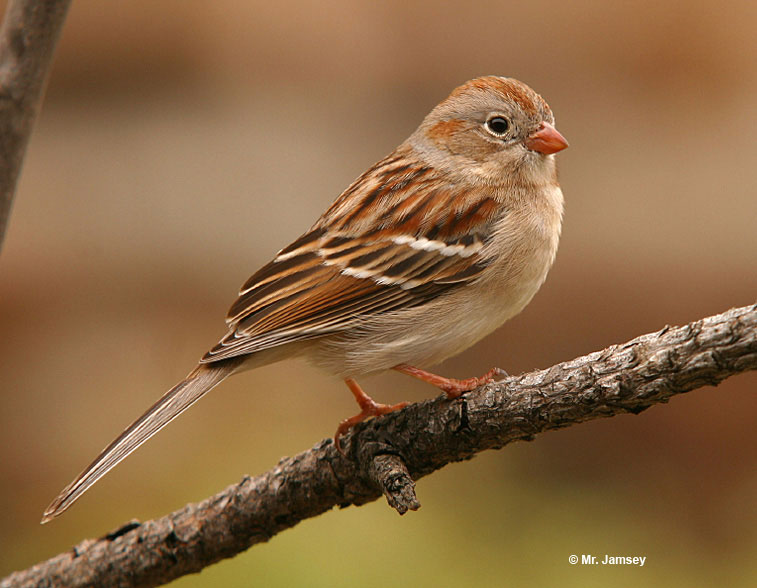The Field Sparrow (Spizella pusilla) is a charming and slender species that graces the open shrubby habitats of the eastern United States.
Their subtle plumage of brown and gray helps them blend seamlessly into their surroundings. However, there are some rather similar sparrow species, so take a closer look at how to identify it!
On this page
Identification
Field Sparrows are relatively small birds, measuring about 4.5 to 6 inches in length with a wingspan of about 8 inches. Female Field Sparrows are slightly smaller than males.
Their overall body shape is similar to other sparrow species, but they’re slenderer. They have short, pink conical bills, relatively long, notched tails, rounded heads, and pink legs and feet.
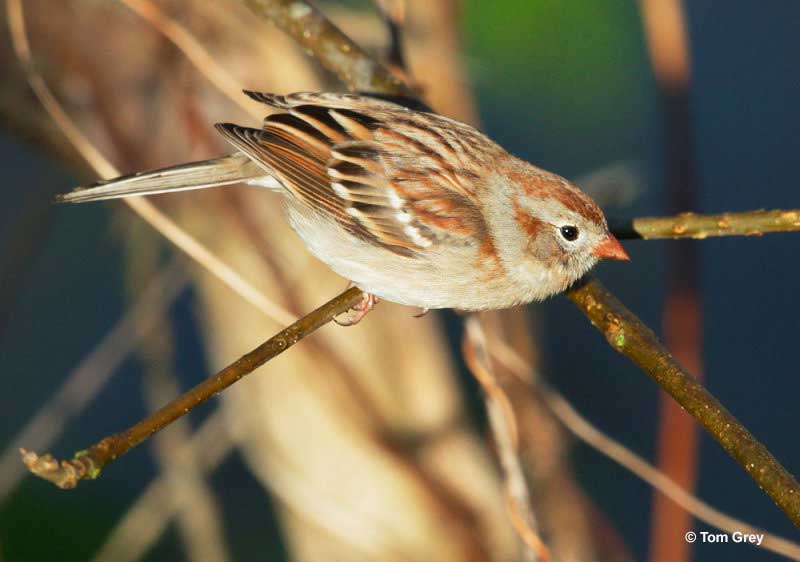
Both female and male Field Sparrows have the same plumage. There are, however, two color morphs: gray and rufous. Both morphs have a brown back streaked with black, gray bellies, and two white wing bars.
The gray morph has a more buffy or grayish breast and appears duller and grayer overall whereas the rufous morph has a rust-colored breast and has warmer-toned reddish-brown in its plumage.
One of their most noticeable features is the distinct facial pattern. They have a gray face, a rust-colored crown and eye line, and a white eyering around their eyes.
Juvenile Field Sparrows look quite similar to adults but they have dark streaking on their sides and chest and lack the vibrant rust-colored crown and eye line.
Vocalizations
Field Sparrow’s song is an accelerating series of short whistles that culminate in a rapid trill lasting about 4 seconds. Males sing a more complicated version of it in the morning.
Their most common calls are seep, chip, cricket calls, and zeeee.
Food
Throughout the year, Field Sparrow’s diet primarily consists of grass seeds, such as panic grass, horseweed, foxtail, and crabgrass. In the winter, these seeds can make up as much as 90% of their diet!
During the summer, however, about half of their diet consists of both larval and adult insects, including caterpillars, grasshoppers, spiders, flies, beetles, cicadas, weevils, butterflies, and spittlebugs.
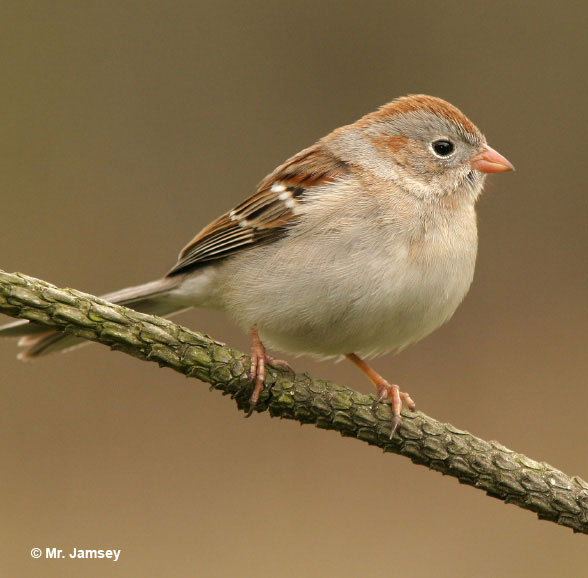
During the breeding season, they forage alone or with their mate while in winter, they may form small foraging flocks. They forage on the ground or in low vegetation, perching on stems and bending them to the ground to snatch seeds.
These sparrows also briefly use perches to scan the surroundings for insects.
Nesting and Eggs
This species is monogamous. Male Field Sparrows use their complex songs to establish and defend their nesting territory and simple songs to attract a mate. Once the bond has been formed, singing becomes less frequent, and the pair starts looking for a nesting site. The female makes the final selection.
Field Sparrow nests are typically close to the ground or on ground level in low but dense bushes, at the base of a shrub, or in tall and thick grass.
They prefer sites far from human habitation. Although the male may assist with gathering materials, then the building process falls solely on the female. The nest is an open cup 3-8 inches across and 2-4.5 inches high, made of grasses and lined with hair and finer plant material.
These sparrows attempt up to 5 broods per breeding season with 2-6, mostly 3-5 eggs. Field Sparrow eggs are under an inch long and about half an inch wide. They are pale, white to creamy or bluish-white, and spotted with brown or gray.
The female incubates the eggs for 10-17 days. Both parents feed the younglings. However, if the female starts another nesting attempt, then the male is left to rear the young until they fledge (at around 7-8 days after hatching) and become independent (at around 24-36 days after hatching).
Current Situation
Field Sparrows range throughout the eastern United States and the northernmost breeders can be seen in limited parts of southernmost Canada. They are partially migratory.
The northern populations fly to the southern United States and northern Mexico for the winter. However, their breeding and wintering ranges have a big overlap and the birds there are year-round residents.
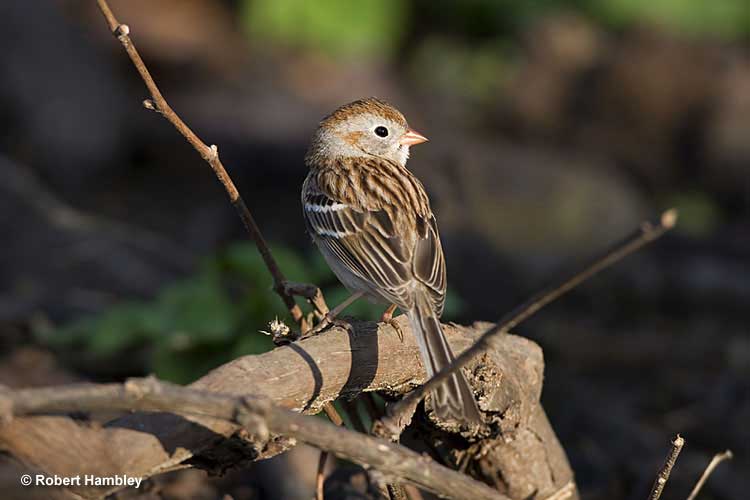
Field Sparrows prefer open shrubby habitats such as grasslands, savannahs, old fields, forest edges and openings, brush, and scrubs. They avoid human settlements even if the area would be suitable otherwise.
Field Sparrows are listed as of least concern on the IUCN Red List since they have a wide range and a population of around nine million mature individuals.
However, since they have specific habitat preferences, are sensitive to disturbance, and are shy of humans and human settlements, their numbers have been in decline.
Facts
- Field Sparrows, as a general rule, raise about 2-3 successful broods. However, since they are quick to abandon nests when it is parasitized by cowbirds or disturbed by predators or other factors, they may and often will have more broods (although some may be unsuccessful). One female made 10 attempts during one breeding season!
- The oldest known Field Sparrow lived to be 10 years and 11 months old. This is impressive, considering that only half of the fledglings survive their first year, and from there on only 53% of males and 36% of females survive annually.
- In winter, you may find Field Sparrows foraging with other bird species, including sparrows. However, due to their calmer nature, they often find themselves at the bottom of the flock hierarchy, which forces them to take risks to get food.
- Field Sparrows are known to attack cowbird models. They are especially aggressive in areas where there’s a high risk of nest parasitism.
Similar Species
Many sparrow species are quite similar and hard to distinguish, including the Field Sparrow. We have highlighted the three most similar species and introduced how to tell the difference.
American Tree Sparrow
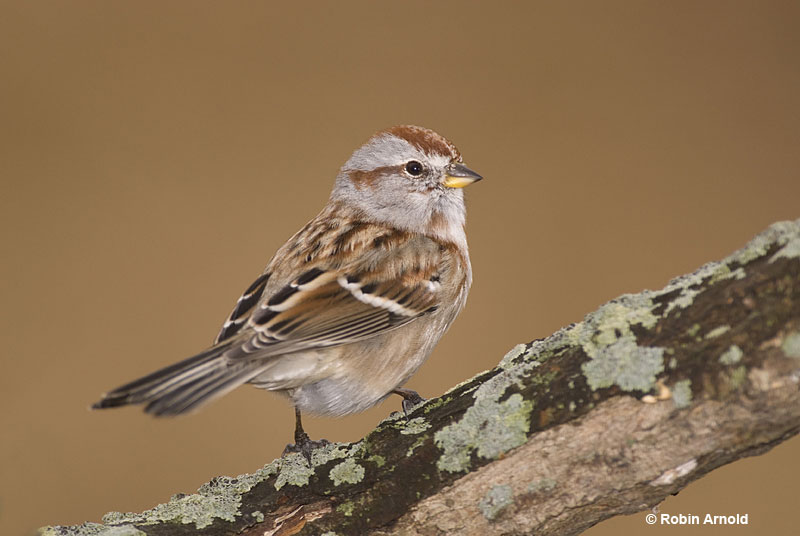
American Tree Sparrows have almost identical plumage to Field Sparrows, so it’s much easier to differentiate it based on its bill and legs. Their bills are black-and-yellow instead of pink and their feet are black instead of pink. You can see them almost all across the United States but only during the winter months. They breed in northern Canada and Alaska.
Chipping Sparrow
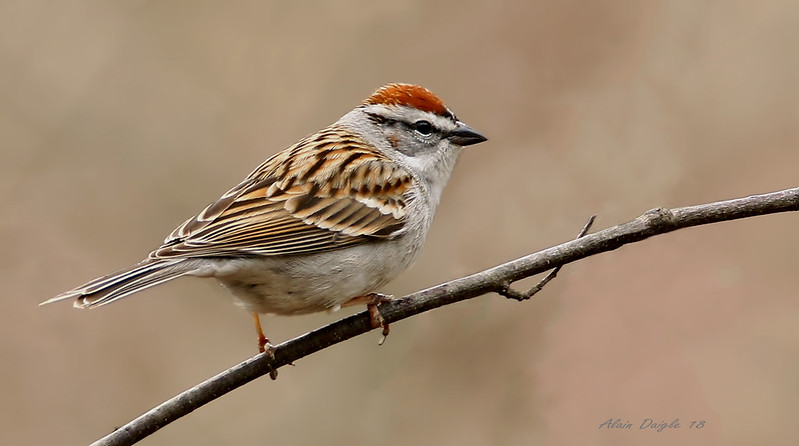
© Alain Daigle
During the breeding season, Chipping Sparrow have a black eye line and a white stripe above it. They also have black bills instead of pink. During the non-breeding season, the eye line is a bit fainter and their face is buffy.
Swamp Sparrow
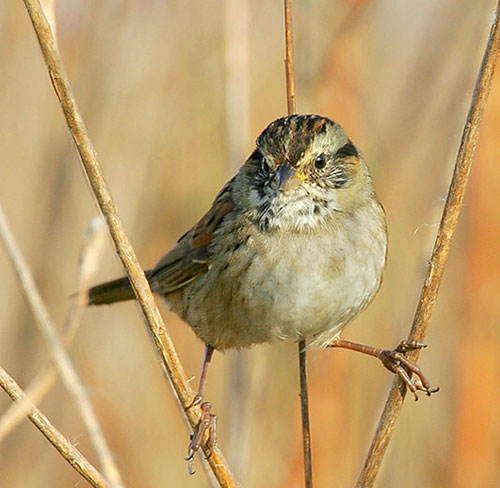
Swamp Sparrows have darker gray and brown underparts and they do not have the Field Sparrow’s pink bill. They’re darker colored overall.
Frequently Asked Questions
What does a Field Sparrow look like?
Field Sparrows are small birds with brown upperparts and gray underparts. They have a gray head, a rust-colored crown and eye stripe, and a white eye ring.
Where does the Field Sparrow live?
Field Sparrows live in open shrubby habitats in the eastern United States.
Are Field Sparrows migratory?
Field Sparrows are partially migratory with their northernmost populations migrating to south for the winter and some of the population being resident year-round.
How long does a Field Sparrow live?
The average lifespan of a Field Sparrow is around 2-3 years. The oldest Field Sparrow lived almost 11 years!
What is the difference between American Tree Sparrow and Field Sparrow?
Field Sparrows have pink bills and feet whereas American Tree Sparrows have black-and-yellow bills and black feet.
Are Field Sparrows aggressive?
Compared to other sparrow species, Field Sparrows are much less aggressive. However, they are still aggressive towards other males and even females of their own species.

